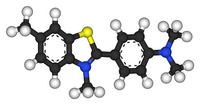Thioflavin
 |
|
 |
|
| Names | |
|---|---|
|
IUPAC name
4-(3,6-dimethyl-1,3-benzothiazol-3
|
|
| Identifiers | |
|
3D model (JSmol)
|
|
| ChEBI | |
| ChemSpider | |
| ECHA InfoCard | 100.017.482 |
|
PubChem CID
|
|
|
|
|
|
| Properties | |
| C17H19ClN2S | |
| Molar mass | 318.86 g/mol |
|
Except where otherwise noted, data are given for materials in their standard state (at 25 °C [77 °F], 100 kPa).
|
|
|
|
|
| Infobox references | |
Thioflavins are dyes used for histology staining and biophysical studies of protein aggregation. They are also used in biophysical studies of the electrophysiology of bacteria.
Thioflavin T (Basic Yellow 1 or CI 49005) is a benzothiazole salt obtained by the methylation of dehydrothiotoluidine with methanol in the presence of hydrochloric acid. The dye is widely used to visualize and quantify the presence of misfolded protein aggregates called amyloid, both in vitro and in vivo (e.g., plaques composed of amyloid beta found in the brains of Alzheimer's disease patients).
When it binds to beta sheet-rich structures, such as those in amyloid aggregates, the dye displays enhanced fluorescence and a characteristic red shift of its emission spectrum. Additional studies also consider fluorescence changes as result of the interaction with double stranded DNA. This change in fluorescent behavior can be caused by many factors that affect the excited state charge distribution of thioflavin T, including binding to a rigid, highly-ordered nanopocket, and specific chemical interactions between ThT and the nanopocket.
Thioflavin T fluorescence is often used as a diagnostic of amyloid structure, but it is not perfectly specific for amyloid. Depending on the particular protein and experimental conditions, thioflavin T may or may not undergo a spectroscopic change upon binding to precursor monomers, small oligomers, unaggregated material with a high beta sheet content, or even alpha helix-rich proteins. Conversely, some amyloid fibers do not affect thioflavin T fluorescence, raising the prospect of false negative results.
...
Wikipedia
